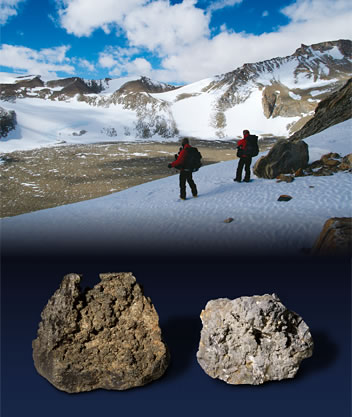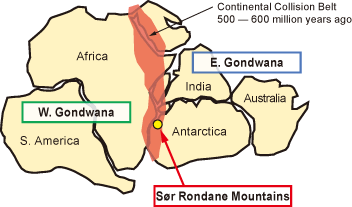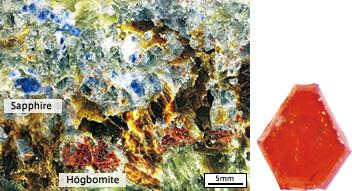
Top: Sør Rondane Mountains
(Photo: Courtesy of Dr. Toshiaki Shimura)
Bottom: Rocks from Mars (left) and the Moon
(Photo: Courtesy of NIPR)
The Earth’s history is right under our feet, locked inside minerals, naturally occurring homogeneous substances such as quartz and graphite. Our solar system’s history, on the other hand, literally falls from the sky in meteorites. Antarctica has an abundance of both (for example, JARE has found about 17,000 meteorites — 1.7 tons’ worth) and scientists analyzing them are making astounding discoveries.
Stories hidden in meteorites
Most of the meteorites JARE has found in Antarctica originated in the asteroid belt between Mars and Jupiter; others came from the Moon and Mars. The National Institute of Polar Research (NIPR) keeps the meteorites for research and reference, but also makes them available to schools and museums around Japan.
Meteorites fall all over the Earth, but why are they so abundant and relatively easy to find in Antarctica? Dr. Hideyasu Kojima, meteorite curator and professor of the geoscience group at NIPR, wondered the same thing. “I thought there was probably a mechanism responsible for the accumulation of meteorites,” he says. Kojima and the JARE team conducted research that led to an explanation: the Meteorite Accumulation Mechanism.
“A depth of about 100m (328 ft.) of snow covers the Antarctic ice. This gradually changes into ice. Meteorites on the surface get buried and move in the ice sheet and glaciers. When a glacier encounters a mountain range, however, it slows down and the surface ice sublimes, churning the meteorites up to the surface, where they are exposed by wind and sunlight. We can easily find them because they sit conspicuously atop the white ice.”
Meteorites allow scientists to look back in time 4.6 billion years, when our solar system was born. The oldest rocks on Earth date to about 4 billion years ago, so meteorites — and samples returned from asteroids — can reveal more than half a billion years of history.
“Meteorites are jigsaw puzzle pieces,” Kojima says. “They were scattered 4.6 billion years ago when the solar system was born. By collecting them and using them to fill gaps in history, we can eventually build the original picture. The more pieces we find, the more defined the picture becomes.” His team wants to collect meteorite samples in increments of one million years to understand how the solar system was organized. “We are constantly raising our level of understanding,” he says.
A mineral resurrects a supercontinent

Conceptual illustration of the Gondwana supercontinent
(Courtesy of Dr. Toshiaki Shimura)

The new mineral magnesiohögbomite-2N4S (enlarged and shown to the right), micrographed in the laboratory. It was discovered among sapphire (blue), spinel (light purple), mica (brown), chlorite (light green) and other minerals.
(Photo: Courtesy of Dr. Toshiaki Shimura)
Like meteorites, minerals tell fascinating stories about the past. Dr. Toshiaki Shimura, an associate professor in Niigata University’s Department of Geology, discovered a new mineral during the 50th JARE Sør Rondane Mountains expedition (2008-2009). Dubbed magnesiohögbomite-2N4S, the red mineral illuminated more secrets of the Gondwana supercontinent.
“I was climbing a slope looking for metamorphic rocks,” Shimura recalls. “I found the mineral, and it looked a little unusual to me. I looked at it closely and found a sapphire, but I still couldn’t tell what the other mineral was.” Testing proved that it had a unique chemical composition. “This is when I started thinking that it could be previously undiscovered.”
Where Shimura found this mineral, which he estimates to be about 520 million years old, was significant. The Sør Rondane Mountains cover approximately 18,800km2 (7,259 mi2). Located about 200km (124 mi) from the coast, there is ice and snow cover, but also barren stretches of exposed rock. The range was created 500-600 million years ago when continents collided and formed Gondwana. “The collision started creating a high ridge,” Shimura says. “As this happened, the sapphires [and other minerals] remained stable at high temperatures deep underground. But suddenly, they were pushed to the surface and exposed to cold conditions and lower pressures, which initiated strong chemical reactions among them, producing the new chemical substance magnesiohögbomite-2N4S.”
In Gondwana, present-day African deserts and jungles in Madagascar and Sri Lanka neighbored the Sør Rondane Mountains. “The mineral proves that this collision occurred,” Shimura says. “That is how it was created with such an unusual chemical composition and unique mineral assemblage.”
Shimura’s next challenge is to create magnesiohögbomite-2N4S in the lab, which would reveal the exact conditions in which it forms. Knowing this information could help us understand more about how long it took Gondwana to coalesce, the speed of the collision and other important geological indicators.
- 1. Antarctica: From Uncertainty to Fact
- 2. Meteorites and Minerals: Tableaux of History
- 3. The Oceans and the Skies

